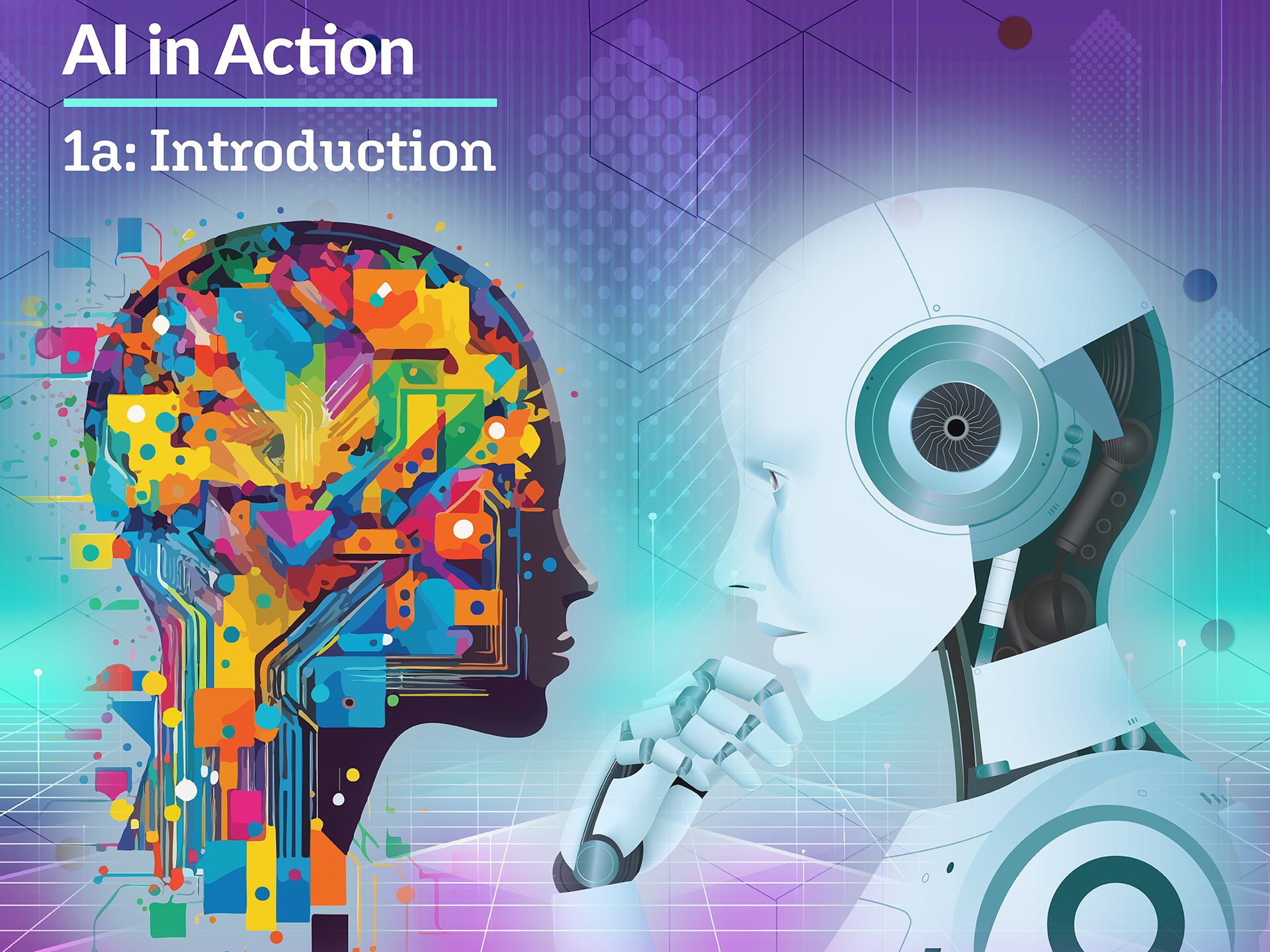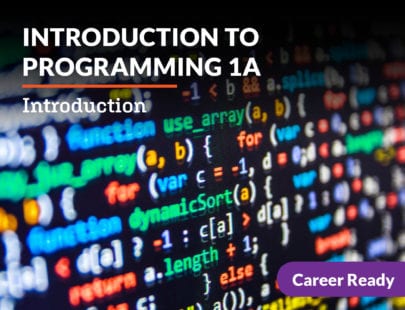
AI in Action 1a: Introduction
Artificial intelligence is not just the future – it is happening right now, all around us! Imagine having the power to unlock answers to questions instantly, or to create your own tools that make life easier. AI makes accessing information and interacting with modern technology easy and fast. But what exactly is AI? And how can you get the most out of it? In this course, you’ll see how AI works and how it can work for you. You will learn the secrets behind AI technologies, push its boundaries, and learn skills that can help you develop your own tool someday. AI is a big wave and it’s coming fast. Let’s learn how to surf!
Units at a Glance
Unit 1: What Is Artificial Intelligence?
Artificial intelligence (AI) seems to be a buzzword these days and for good reason! AI is all around us. It influences how we work, it entertains, it helps us buy products, and it interacts with technology. From voice assistants that understand our questions to robots that can perform surgeries, AI is pushing the boundaries of what machines can do. But how did we get here? In this unit, we’ll explore the evolution of AI, its role in key industries, its impact on society, and the ethical and legal concerns associated with its use. We will even explore the question of whether machines can truly “know” information. By the end, you’ll have a solid understanding of what AI is, how it works, and why it matters. Are you ready?
What will you learn in this unit?
- Assess the intelligence of machines using the sense-deliberate-act cycle
- Define the fields of computer science, artificial intelligence, and machine learning
- Describe the history and evolution of AI
- Explain the societal impacts of AI
- Analyze the challenges and opportunities of current and future AI
Unit 2: AI Applications and Perception Systems
How many AI-powered devices do you interact with on a daily basis? The number might be higher than you realize! These days, AI is integrated into many of the personal products we use regularly, from smart assistants to recommendation systems. AI can now even generate realistic art and music. In this unit, we will explore real-world AI applications. We will also examine the major types of AI and uncover how AI perceives the world through sensors and perception algorithms. Get ready to dive into the fascinating world of AI perception!
What will you learn in this unit?
- Identify and describe examples of AI technology used daily
- Define areas of AI including machine learning, natural language processing, and computer vision
- Describe the differences between human, animal, and AI senses
- Explain how AI uses sensory data to perceive meaning for visual systems
- Recognize how basic types of perception algorithms are used in real-world applications
Unit 3: All About Data
Data is everywhere. It powers the apps we use, helps businesses make informed decisions, and allows us to solve problems. In this unit, we’ll explore what exactly data is, how computers store and process it, and why it plays such a big role in AI. We’ll learn about binaries, different types of data, and where data comes from. We’ll use real datasets to uncover new insights through collecting, organizing, analyzing, and visualizing data using spreadsheet software. Understanding data is the foundation of AI, and soon you’ll have a new appreciation for data!
What will you learn in this unit?
- Identify different types and sources of data
- Describe the data processing cycle
- Understand how AI uses big data
- Collect, organize, manipulate, and analyze data using Google Sheets
- Analyze data to make insightful summaries, decisions, and predictions
Unit 4: AI Representations and Algorithms
How does AI work? That’s a loaded question! You could answer it from a variety of angles, but the truth is that until you discover what’s underneath the hood, so to speak, you will only have a general idea of how AI works. Going deeper requires learning how AI structures the information it uses, and how it applies various algorithms to make decisions. In this unit, we’ll examine how AI represents data, navigates through that data using search algorithms, and applies reasoning techniques on large amounts of data. Are you ready to peel back the layers to discover what’s underneath the AI applications our world uses? Let’s do it!
What will you learn in this unit?
- Identify types of AI representations and how they are used
- Explain how different families of search algorithms find solutions
- Describe how search algorithms are used in real-life AI systems
- Identify and describe how families of reasoning algorithms work
- Understand the advantages and disadvantages of various reasoning techniques
Unit 5: Machine Learning
What do Siri, Netflix, autocorrect, and the Amazon Fashion app have in common? They are all powered by machine learning (ML)! Machine learning is a type of AI that allows computers to learn from data and make predictions or decisions without being programmed with a fixed set of instructions. With uses in speech recognition, image classification, fraud detection, self-driving cars, and recommendation systems, you probably interact with an ML application almost every day. In this unit, we’ll discover how ML works, the different types of ML, and a special kind of ML known as neural networks. You’ll even get to train your very own ML model! Are you ready?
What will you learn in this unit?
- Explain the difference between human learning and machine learning
- Describe and provide examples of supervised and unsupervised learning
- Create and train an ML model using Google’s Teachable Machine
- Identify the components of a neural network and explain how they work
- Describe how CNNs, RNNs, and GANs work
Unit 6: AI: Thinking, Learning, and Playing Like a Human?
What makes a machine intelligent? Does AI have common sense? How is it possible for an AI to solve the most complex board game in the history of mankind, yet struggle with understanding sarcasm? These are all questions we will explore in this unit. We’ll learn about the types of things AI does well and the areas where it still struggles. We’ll see how domain knowledge from a variety of fields plays a crucial role in training ML models and investigate sources of potential bias in that domain knowledge. We’ll conclude by exploring the ways that AI understands human language.
What will you learn in this unit?
- Identify and describe characteristics of human intelligence
- Compare common sense with encyclopedic knowledge and statistical inference
- Predict when an AI will need to depend on knowledge from a specific field
- Suggest ways to reduce bias in an AI system
- Describe the components in speech recognition systems
Unit 7: AI and Human Interaction
When we communicate, we rely on more than just words. We use gestures, facial expressions, and body language to understand how the other person is feeling. For most people, this comes naturally without consciously thinking about it. However, the nuance of human interaction is a huge challenge for AI. In this unit, we’ll explore how AI is learning to understand human language in context, identify emotions, analyze opinions in text, and interact with humans in natural ways. You’ll get to do your own experimenting with sentiment analysis and emotion recognition tools, and we’ll investigate how humans can collaborate with AI to be creative. Get ready to explore the impressive capabilities and current limitations of AI in human interaction.
What will you learn in this unit?
- Describe how tone, intent, and sentiment are used in natural language understanding
- Conduct sentiment analysis experiments
- Model how AI tools identify emotions
- Explore the techniques used in human-robot interaction
- Distinguish between creativity in humans and AI
Unit 8: Ethics, Bias, and Fairness in AI
What should happen if a self-driving car hits a fire hydrant? Who is at fault—the person in the car, the software developer, the car manufacturer, or someone else? Similarly, who is responsible if an AI-powered system utilizes biased data to make decisions? The field of AI ethics seeks to answer questions like these and more. It is concerned with concepts of bias, perception, privacy, and accuracy. In this unit, we’ll take a deep dive into what it means to use AI ethically. We’ll examine the cultural and societal impact of AI, as well as explore challenges around transparency, explainability, and fairness. You’ll gain new insights and be better equipped to think critically about the ethical decisions involved in using and developing AI in a fast-paced technological world.
What will you learn in this unit?
- Explain the ethical use of AI as well as the consequences of inappropriate use
- Frame ethical decisions in a variety of dimensions
- Reduce bias in AI systems
- Advance ethical decision-making in AI
- Evaluate AI’s place in society
Required Materials
Physical
- Art supplies
- Digital camera
- Smartphone
Software
- ChatGPT
- Dialogflow Essentials (login required)
- Google app
- JobsGPT
- Presentation software
- Seeing AI app
- Spreadsheet software
- Teachable Machine
- Word processing software
Other
- Helper
Optional
- Audio recording device
- Graphic design software
- Poster board
- Video recording device

